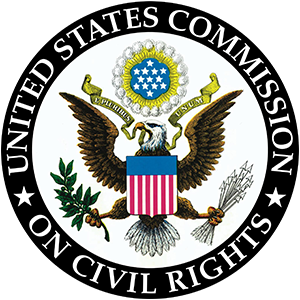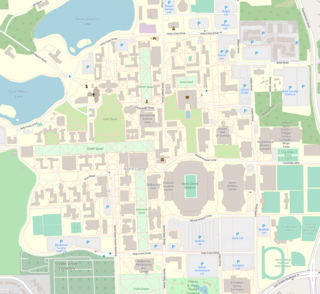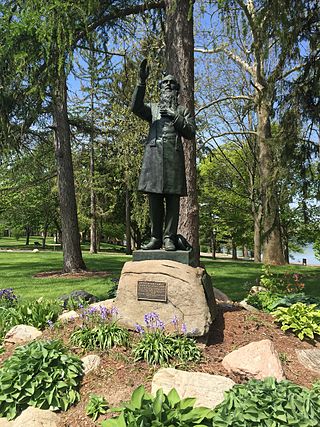
The University of Notre Dame du Lac, known simply as Notre Dame, is a private Catholic research university in Notre Dame, Indiana. Founded in 1842, the main campus of 1,261 acres has a suburban setting and contains landmarks such as the Golden Dome, the Word of Life mural, Notre Dame Stadium, and the basilica. Originally male-only, the university started accepting undergraduate women in 1972.

Theodore Martin Hesburgh, CSC was an American Catholic priest and academic who was a member of the Congregation of Holy Cross. He is best known for his service as the president of the University of Notre Dame for thirty-five years (1952–1987).

Harris Llewellyn Wofford Jr. was an American attorney, civil rights activist, and Democratic Party politician who represented Pennsylvania in the United States Senate from 1991 to 1995. A noted advocate of national service and volunteering, Wofford was also the fifth president of Bryn Mawr College from 1970 to 1978, served as chairman of the Pennsylvania Democratic Party in 1986 and also as Pennsylvania Secretary of Labor and Industry in the cabinet of Governor Robert P. Casey from 1987 to 1991, and was a surrogate for Barack Obama's 2008 presidential campaign. He introduced Obama in Philadelphia at the National Constitution Center before Obama's speech on race in America, "A More Perfect Union".

The U.S. Commission on Civil Rights (CCR) is a bipartisan, independent commission of the United States federal government, created by the Civil Rights Act of 1957 during the Eisenhower administration, that is charged with the responsibility for investigating, reporting on, and making recommendations concerning civil rights issues in the United States. Specifically, the CCR investigates allegations of discrimination based on race, sex, national origin, disability. In December 2023, Rochelle Mercedes Garza was appointed to serve as Chair of the CCR. She is the youngest person to be appointed to the position.
The 1988 Notre Dame vs. Miami football game was a college football game played between the Miami Hurricanes of the University of Miami and the Fighting Irish of the University of Notre Dame on October 15, 1988, at Notre Dame Stadium in Notre Dame, Indiana.
The Rev. John Joseph Cavanaugh, C.S.C., was an American Roman Catholic priest of the Congregation of Holy Cross, served from 1946 to 1952 as the 14th president of the University of Notre Dame, having previously served as its vice president since 1941.

Badin Hall is one of the 32 Residence Halls on the campus of the University of Notre Dame and one of the 14 female dorms. The smallest residence hall on campus, it is located on South Quad, between Howard Hall and the Coleman-Morse center. It was built in 1897 and hosted the Manual Labor School until 1917 before being converted into a men's dorm. During World War II, it was part of the United States Naval Reserve Midshipmen's School, and in 1972 it became one of the first two residence halls at Notre Dame to host women.
Catholic Democrats is an American not-for-profit organization of Catholics to support the Democratic Party, based in Boston, United States. The Catholic Democrats have more than 60,000 members in all 50 American states and Puerto Rico. It claims no authorization from the Catholic Church, or any Catholic bishop, Catholic diocese, candidate or candidate committee.

The College of Arts and Letters is the oldest and largest college within the University of Notre Dame. The Dean of the College of Arts and Letters is Sarah Mustillo.
The Notre Dame Queer Film Festival was founded in 2004 and ran in 2005 under the same moniker. In 2006, under pressure from a new administration led by University President Rev. John I. Jenkins, the name of the festival was changed to Gay and Lesbian Film: Filmmakers, Narratives, Spectatorships. The 2007 incarnation of the festival again changed names to Qlassics: Reimagining Sexuality and the Self in Recent American Cinema. More recently, the series has been titled the GlobaLGBTQ+ Film Festival, with a primary focus on films produced outside of the United States.

Patrick Creadon is an American filmmaker and actor primarily known for his work in documentaries. His first film, Wordplay, profiled New York Times crossword editor Will Shortz and premiered at the 2006 Sundance Film Festival. The film screened in over 500 theatres nationwide and became the second-highest grossing documentary of that year. His second film, I.O.U.S.A., is a non-partisan examination of America's national debt problem and forecast the global financial crisis of 2007-2008. I.O.U.S.A. premiered at the 2008 Sundance Film Festival and was later named one of the Top 5 Documentaries of the Year by film critic Roger Ebert.

Theodore Hesburgh Library is the primary building of the University of Notre Dame's library system. The present-day building opened on September 18, 1963, as Memorial Library. In 1987, it was renamed Hesburgh Library, in honor of Rev. Theodore Hesburgh, C.S.C., who served as the university's president from 1952 to 1987. The library's exterior façade that faces the university's football stadium includes a large, 134-foot (41 m) by 68-foot (21 m) mural called Word of Life, or more commonly known as Touchdown Jesus. As of 2009, the library ranked as the 61st largest collection among research universities in the United States, with an estimated 3.39 million volumes.

The University of Notre Dame was founded on November 26, 1842, by Father Edward Sorin, CSC, who was also its first president, as an all-male institution on land donated by the Bishop of Vincennes. Today, many Holy Cross priests continue to work for the university, including as its president. Notre Dame rose to national prominence in the early 1900s for its Fighting Irish football team, especially under the guidance of the legendary coach Knute Rockne. Major improvements to the university occurred during the administration of Rev. Theodore Hesburgh between 1952 and 1987 as Hesburgh's administration greatly increased the university's resources, academic programs, and reputation and first enrolled women undergraduates in 1972.

The campus of the University of Notre Dame is located in Notre Dame, Indiana, and spans 1,250 acres comprising around 170 buildings. The campus is consistently ranked and admired as one of the most beautiful university campuses in the United States and around the world, particularly noted for the Golden Dome, the Basilica and its stained glass windows, the quads and the greenery, the Grotto, Touchdown Jesus, its collegiate gothic architecture, and its statues and museums. Notre Dame is a major tourist attraction in northern Indiana; in the 2015–2016 academic year, more than 1.8 million visitors, almost half of whom were from outside of St. Joseph County, visited the campus.

Chaplain Corby of Gettysburg is an outdoor sculpture by American artist Samuel Murray (1869–1941). It is located on the University of Notre Dame campus, and is owned by the University. The sculpture, made of bronze and limestone, depicts Father William Corby giving absolution to soldiers at the Battle of Gettysburg.

Fathers Theodore Hesburgh and Edmund Joyce is an outdoor statue on the University of Notre Dame campus. Located on the South side of the Hesburgh Library facing the reflecting pool, the sculpture was designed and built by artist Lou Cella, a member of the Rotblatt-Amrany Fine Art Studio, and is currently owned by the University of Notre Dame.

Amy Vivian Coney Barrett is an American lawyer and jurist who serves as an associate justice of the Supreme Court of the United States. The fifth woman to serve on the court, she was nominated by President Donald Trump and has served since October 27, 2020. Barrett was a U.S. circuit judge on the U.S. Court of Appeals for the Seventh Circuit from 2017 to 2020.
Neil Gerard McCluskey, a former Jesuit Catholic priest known as Reverend Neil Gerard McCluskey, S.J. from 1938 to 1975, was a prominent voice for Catholic Education in the United States in the time of Vatican II. McCluskey wrote the famous Land O'Lakes Statement, as a member of the committee headed by Fr. Theodore Hesburgh. McCluskey was also the last surviving nephew of Blessed Solanus Casey.

Christine O'Malley is an American film producer and documentary filmmaker.

Catholics vs. Convicts is a 2016 documentary film about the October 15, 1988 Notre Dame-Miami football game between the Miami Hurricanes of the University of Miami and the Notre Dame Fighting Irish of Notre Dame.
















